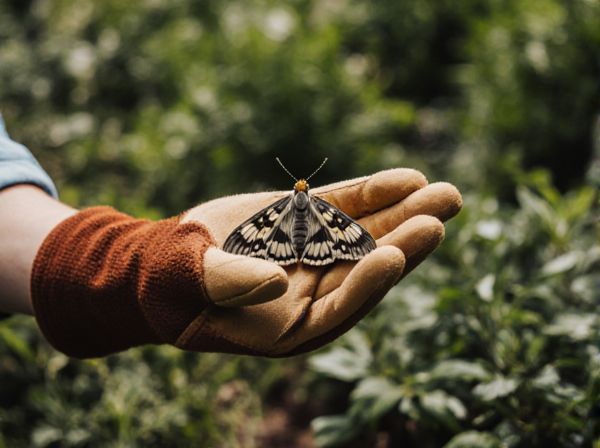
Moth vs Bat Pollinator Illustration
Moths and bats both serve as vital nocturnal pollinators, but moths typically pollinate flowers with strong scents and pale colors that open at night, while bats target larger, more robust flowers with ample nectar. Moth pollination often involves smaller flowers adapted to their long proboscises, whereas bats pollinate flowers designed to withstand their weight and often emit fruity or musky odors. This divergence in pollination strategies highlights the complementary roles moths and bats play in supporting diverse ecosystems through nighttime pollination.
Table of Comparison
| Feature | Moth Pollinator | Bat Pollinator |
|---|---|---|
| Pollination Time | Nocturnal | Nocturnal |
| Pollination Method | Proboscis to collect nectar and transfer pollen | Face and fur collect pollen while feeding on nectar |
| Flower Preference | Typically small, light-colored, fragrant flowers | Large, sturdy, often white or pale flowers with strong scent |
| Range | Short to moderate distances | Long distances due to strong flight |
| Ecosystem Role | Supports nocturnal flowering plants | Pollinates night-blooming fruit and agave plants |
| Size | Small to medium-sized insects | Medium to large mammals |
Introduction to Moth and Bat Pollinators
Moth pollinators, primarily nocturnal, rely on their keen sense of smell and night vision to locate flowers with pale colors and strong fragrances, facilitating pollination in low light environments. Bat pollinators, especially prevalent in tropical and desert ecosystems, use echolocation to find flowers rich in nectar, often large and sturdy to support their weight. Both moths and bats play crucial roles in the reproductive cycles of various plant species by ensuring cross-pollination in habitats where daytime pollinators are less active.
Unique Pollination Mechanisms of Moths
Moths utilize a distinctive pollination mechanism involving their long, slender proboscises that enable them to access nectar deep within flowers, facilitating pollen transfer in species with tubular corollas, such as evening primroses and hawk moth-pollinated orchids. Their nocturnal activity aligns with night-blooming plants that emit strong, sweet fragrances to attract them, ensuring effective cross-pollination. Unlike bats, moths rely on subtle flight patterns and sensitive antennae to locate flowers, which contributes to specialized plant-moth coevolution in various ecosystems.
Distinctive Pollination Roles of Bats
Bats serve as vital nocturnal pollinators primarily for night-blooming plants with large, fragrant flowers that produce abundant nectar, such as agaves and saguaro cacti. Unlike moths, which tend to pollinate smaller, tubular flowers using their long proboscis, bats use their sense of smell and echolocation to locate flowers, facilitating cross-pollination over longer distances. The distinctive pollination role of bats supports ecosystem diversity and the reproduction of key plant species crucial to arid and tropical environments.
Key Plant Species Pollinated by Moths
Moth pollinators primarily target nocturnal flowering plants such as yucca, evening primrose, and certain species of orchids that release strong fragrances at night to attract them. These plants have adapted by developing pale or white flowers that are more visible in low light, ensuring effective pollination by moths. Unlike bats, which often pollinate larger, more robust flowers like agave and durian, moth-pollinated species tend to have delicate, tubular blossoms suited to moth proboscises.
Key Plant Species Pollinated by Bats
Bats play a crucial role in pollinating key plant species such as agave, durian, and balsa trees, which rely heavily on chiropterophily for reproduction. Unlike moths that typically pollinate night-blooming flowers with strong scents and pale colors, bats are attracted to larger, more robust flowers that provide ample nectar and withstand bat visits. The mutualistic relationship between bats and these plants ensures genetic diversity and ecosystem stability in tropical and subtropical environments.
Nocturnal Adaptations of Moths and Bats
Moths and bats exhibit specialized nocturnal adaptations that enhance their efficiency as pollinators in darkness. Moths rely on sensory antennae to detect floral scents and possess hearing mechanisms to evade predators, enabling precise flower location at night. Bats utilize echolocation to navigate and pinpoint nectar-producing flowers, coupled with strong flight capabilities to cover extensive foraging areas during nighttime hours.
Ecological Impacts of Moth vs Bat Pollination
Moth pollination significantly enhances nocturnal plant reproduction by supporting a diverse range of flowering species adapted to night-time pollinators, which helps maintain ecosystem biodiversity. Bat pollination plays a crucial role in tropical and subtropical habitats by aiding the pollination of large, robust flowers such as those of agave and durian, facilitating seed production and forest regeneration. Both moths and bats contribute uniquely to ecological balance, with moths promoting genetic diversity in understory plants and bats ensuring the survival of keystone tree species essential for wildlife habitat.
Geographic Distribution of Moth and Bat Pollinators
Moth pollinators are predominantly found in temperate and tropical regions worldwide, with high diversity in Southeast Asia, Central America, and parts of Africa. Bat pollinators, primarily nectar-feeding fruit bats, are concentrated in tropical and subtropical areas such as Central and South America, Africa, and Southeast Asia. The overlapping geographic distribution of moth and bat pollinators in these regions supports diverse nocturnal pollination networks essential for many flowering plants.
Challenges and Threats to Moth and Bat Pollinators
Moth and bat pollinators face significant challenges due to habitat loss, light pollution, and pesticide exposure, which disrupt their foraging patterns and reproductive cycles. Moths are particularly vulnerable to artificial lighting that interferes with their nocturnal navigation, while bats suffer from diseases such as white-nose syndrome and sensitivity to chemical contaminants. Conservation efforts must address these threats by protecting natural habitats, reducing light pollution, and regulating pesticide use to maintain the essential ecological roles of these pollinators.
Conservation Strategies for Moth and Bat Pollinators
Conservation strategies for moth and bat pollinators emphasize habitat preservation, including protecting native flowering plants and roosting sites essential for their survival. Implementing light pollution controls mitigates disruption to nocturnal behaviors critical for effective pollination. Promoting community awareness and research efforts enhances data collection, ensuring targeted actions support both moth and bat populations sustainably.
Moth vs Bat Pollinator Infographic

 gardendif.com
gardendif.com